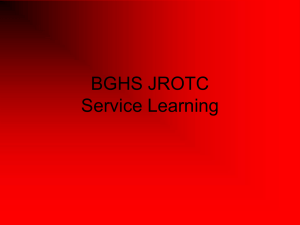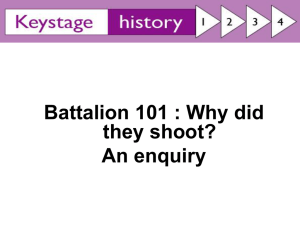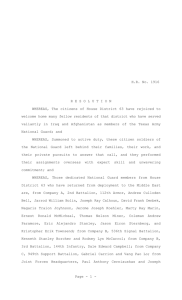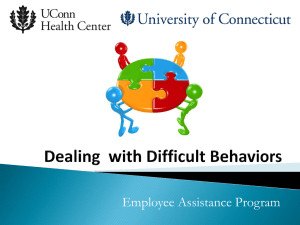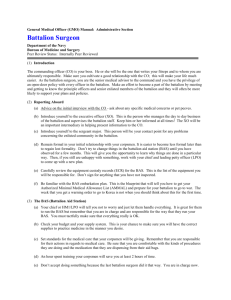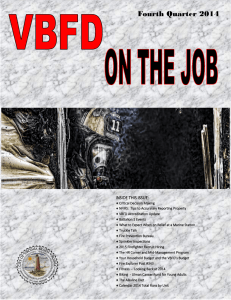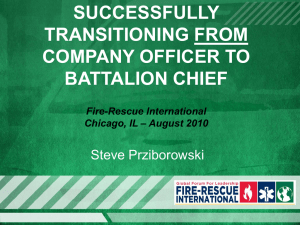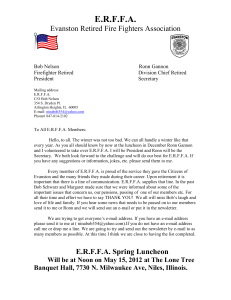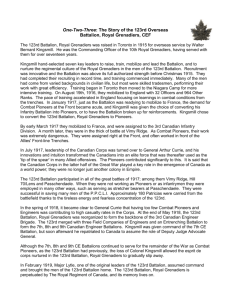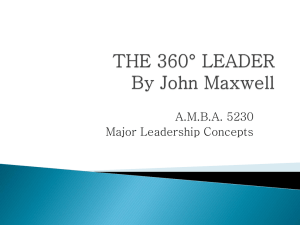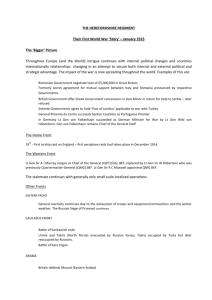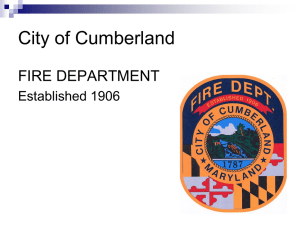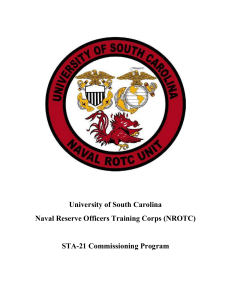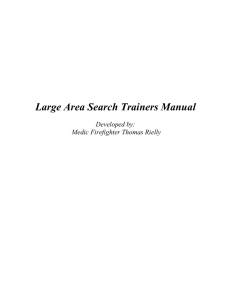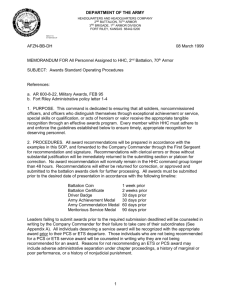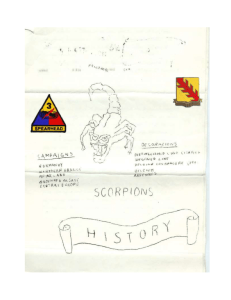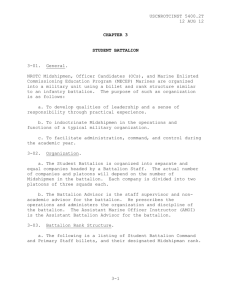Metro Fire Officers Academy
advertisement
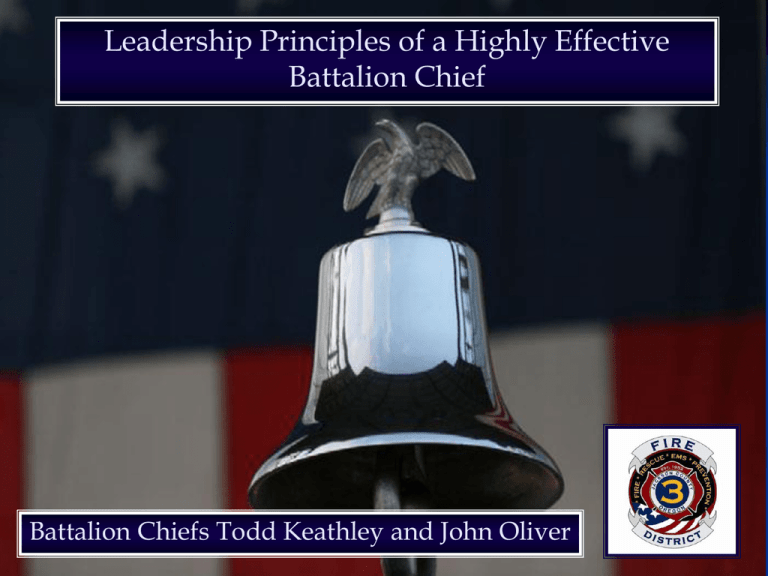
Leadership Principles of a Highly Effective Battalion Chief Battalion Chiefs Todd Keathley and John Oliver Leadership What is Leadership? True leadership cannot be awarded, appointed or assigned. It comes only from influence Why is leadership important? Leadership ability is the lid that determines your level of effectiveness The single most important ingredient in the formula of success is knowing how to get along with people. Theodore Roosevelt Qualities of a Leader Trusted Respected Competent Committed Positive attitude Consistent Personal character Integrity Leads by example Inspires others The measurement of a leader - How many other people have you helped to be successful Qualities of a Leader Trusted Respected Competent Committed Positive attitude Consistent Personal character Integrity Leads by example Inspires others Leadership is not a position, it’s a disposition WES CLAFLIN AWARD - STACY MAXWELL, CFO SCARLET AWARD - BRIAN MURDOCK, FIREFIGHTER VALOR AWARD - ROGER ADAMS, RETIRED BATTALION CHIEF INSTRUCTOR OF THE YEAR - AARON BACKUS, CAPTAIN CAREER DISTINGUISHED SERVICE AWARD - DAN MAHAR, ENGINEER VOLUNTEER DISTINGUISHED SERVICE AWARD LORIN MYERS, CHAPLAIN Qualities of a Leader Leadership is firefighter safety Trusted Respected Competent Committed Positive attitude Consistent Personal character Integrity Leads by example Inspires others Lessons learned from the SC fatal fire: Tragedy to Triumph The instructor relates how this tragedy has changed the department forever and caused a transition from operating with outdated, unsafe practices to a department leading the way in education and training on a national level. The instructor explains how improper leadership, education and organizational culture lead to this senseless tragedy. This event is reflected in the changes seen in almost every operation the department performs. Among the changes address are new hiring criteria, fair promotional policies based on performance not popularity, and the development of many training programs. 2013 FDIC Symposium What does success as a Battalion Chief look like to you? When you have earned the trust and respect of your subordinates, colleagues and superiors. Leadership Can leadership be learned? In fact, there is no greater return on your investment then the effort that you will put into being a leader. It takes a conscious effort on your part. Start making the investment today. Take good leaders and make them great Leadership How do we develop our leadership skills? The first person we must examine is ourselves - Mirror Who we are determines how we see others - Lens Leadership is not developed in a day, it’s developed daily Tell me your favorite leadership book or author? Getting Real Admit your faults Ask for advice Worry less about what others think, reputation verses integrity Be open to learning from others Put away pride and pretense One of the nice things about being imperfect is the joy that it brings to others Strength Based Leadership CEO’s of major corporations are great at one aspect of their industry. They surround themselves with people that possess the skill sets they don’t have. Roy Disney, Steve Jobs. The Universal Fear – That at some point someone’s going to realize it’s just me. See yourself as a Battalion Chief that doesn’t have all the answers but someone who will use their skills and the skills of their co-workers to meet the responsibilities of the position. Five levels of leadership #5 Personhood – People follow you because of who you are and what you represent #4 People development – People follow you because of what you have done for them #3 Production – People follow you because of what you have done for the organization #2 Permission - People follow you because they want to #1 Position - People follow you because they have to Building Trust There are three qualities a leader must exemplify to build trust Competence Character Connection – personally & professionally Work Marriage Finances Family Children Health issues Substance abuse Personal Character Demonstrated in the little decisions made everyday Decisions – character or compromise: Do the right thing, even if that choice brings negative consequences. Leaders cannot rise above the limitations of their character, especially when it comes to leadership. Character makes trust possible and trust makes leadership possible. Your actions have to match your words. Building Trust PepsiCo chairman and CEO Craig Weatherup acknowledges, “People will tolerate honest mistakes, but if you violate their trust you will find it very difficult to ever regain their confidence. That is one reason that you need to treat trust as your most precious asset. You may fool your boss but you can never fool your colleges or subordinates.” John Maxwell – Leadership 101 Building Trust How to you secure a positive influence in the organization? “You don’t build trust by talking about it. You build it by achieving results, always with integrity and in a manner that shows real personal regard for the people with whom you work.” John Maxwell – Leadership 101 Gaining Respect The transition from a member of the crew to the Battalion Chief You can’t force it You can’t demand it Let people come to their own conclusion When in command, take command Be flexibly concrete Treat people as you want them to be Believe in your people before they believe in themselves Gaining Respect Take responsibility for your mistakes Give away the credit Push recognition down Be a humble leader Delegate effectively Lead by example What should you expect from your Captains ? Role of the Company Officer Most important position in the Fire Service Direct supervision of Firefighters Training (be the catalyst) Be a student of the job Be a coach and mentor Clearly define employee expectations Confirm employee knowledge of policies and procedures Most Important job of a Company Officer? To implement the goals and objective of the organization on a daily basis as they've been defined by your administration. Through the use of PPE Policies, Procedures and Expectations Where do the policies and procedures in the Fire Service come from? Injuries & fatalities Best Practice Minimum Standard If your organization killed a firefighter today, what policies, procedures, practices and philosophies would we change tomorrow? Many causes are fundamental and rudimentary in nature Organizations make sweeping changes after the fatal event Fundamentals Poor apparatus placement Improper line selection/placement Poor radio communications Free lancing/lack of team continuity Applying offensive tactics to a defensive situation Lack of equipment maintenance Failure to evaluate risk versus benefit Lack of equipment knowledge/familiarity Crew attempted to follow hose lines on the floor to locate the exit; however, hose lines were tangled on the floor, creating a problem on exiting Firefighters located a hose line and were following the line out but discovered they were going back into the structure when they reached the nozzle “Champions don’t beat themselves If you want to win, do the ordinary things better then anyone else – day in and day out. We’re not going to fool people or out scheme them. We’re just going to outplay them. Because we’ll know what we’re doing. When we get into critical situations, we won’t have to think. We’ll play fast and fundamentally sound.” Chuck Noll Defining Expectations Be familiar with the organizational policies and procedures Identify areas of importance or concern Define your personal expectations Provide organizational and personal expectations to your members “in-writing” Promotes employee success Prevents injuries and fatalities Prevents conflict #1 reason for employee supervisor conflict Lack of or misunderstanding of employee expectations Handout On February 10, 2010, a 69-year-old male Fire Chief (the victim) died after being crushed between a parked tanker and a pumper being backed into the fire station. NIOSH Report – January 2012 One Career Fire Fighter Killed, Another Seriously Injured When Struck By a Vehicle While Working at a Grass Fire Along an Interstate Highway Content of interior radio reports Location, Location Heat conditions Visibility Possible extension Hazardous conditions Changing conditions Overcrowding Interior size up Recommendation Instruct firefighters not to overcrowd the area of the interior attack team. On December 20, 2004, a 24-year-old male career probationary firefighter (the victim) died after he became separated from a fire-attack team at a twoalarm, single-story, residential structure fire. Solutions for overcrowding? Identify overcrowding as a safety issue Appropriate use of resources by Incident Commander Location for Back-up line Feedback from interior crews It’s better to prepare then to repair Define expectations early and often ! If Only Implementing a program or change that you don’t agree with Educate yourself Tell your members WHY Listen to their concerns Look for opportunities to improve the program or change Provide feedback Circle of influence Total Control Influence No Control Ways to improve your team Improve yourself – leaders are learners Identify team’s strengths and train to improve weaknesses Recognize individual performance and achievement Assist subordinates in reaching their goals Evaluate attitudes (expand their focus) Prepare – the 6 P’s As the supervisor goes, so goes their subordinates. Ways to improve your team The secret to your success and the success of your team is found in your daily agenda Champions don’t become champions in the ring, they are merely recognized there. If you want to see where someone develops into a champion, look at their daily routine. John Maxwell 3 Area’s that Determine an Employee’s Success Conceptual Technical Human Harvard Business Review Conceptual Organizationally, where have we been, where are we today and where are we going in the future Quarterly Report Strategic Plan Standard of Cover Budget Annual Newsletter Technical Are you capable of making emergency scene decisions in accordance with your policies & procedures that keep people safe and in a manner that reflects a command presents? Fire Ground Hazardous Materials MCI Confined Space Water Rescue Human What kind of character and skills do you demonstrate when dealing with people Dealing with conflict Dealing with the poor performer Creating a positive work environment Demonstrating a genuine respect for people Dealing with the public Dealing with Conflict It’s unavoidable Nobody likes conflict Why is it difficult to confront? Fear of being disliked Fear of being misunderstood Fear of rejection Fear of the unknown Harmful Strategies Win at all cost Whine about it Pulling rank Pretend it doesn’t exist Conflict is like cancer, early detection increases the possibility of a healthy outcome. Conflict / Poor Performance 80% of the time people don’t realize there is a problem 30% of them realize there is a problem, but don’t know how to solve it 20% percent realized there is a problem, but don’t want to solve it Your job is to tell people what reality is Healthy Conflict Resolution 1. Care before you confront. What's best for the employee? 2. Meet together ASAP. 3. First seek understanding, then agreement. 4. Outline the problem: • Describe your perception • Explain why it’s important to you • Tell how it impacts you and/or the team Healthy Conflict Resolution 5. Encourage a response and “listen”. Listening will: Confirm your perception is accurate Identify extenuating circumstances Better understand the problem Employee needs to know they were heard 6. Agree to an action plan What does the corrected behavior or performance look like? Dealing with Poor Performance Identify the problem, not a symptom Skill or will • Attitude or knowledge • How is this effecting the individual and or the team? Dealing with Poor Performance Identify the performance issue for the employee Let the employee respond and listen Identify future expectations for the employee What does the employee need from you to meet these expectations or be successful? Show confidence in the employee, you are in this together See this as a training opportunity Workplace Environment Lead by example Basic level of RESPECT Good general conduct Impact and consequences The inappropriate actions of an employee will impact them and you! Conduct in the Workplace How long will it be funny? You can’t put the genie back in the bottle What is funny in a fire station has no humor in a court of law Even if you win in a court, you loose There are no special rules or consideration for the fire service work environment or schedule If what was said in your fire station today was printed in the newspaper tomorrow, how would it sound? Conduct in the Workplace Supervisors Are expected to maintain a productive, non-hostile work environment. Are expected to educate employees about rules and conduct that violates policies involving jokes, comments, actions, electronic devices, etc. STOP Employee Performance/Behavior Counseling Discipline • Begin with the end in mind, what do you want to accomplish? Take the personalities out of it • • Everyone else is watching Steps for a counseling session Identify the problem - be specific In writing – dates, times, members present and circumstances Let employee give input and listen to the employee’s point of view Stay on task an on topic Define future objectives, expectations/performance Calm voice, no emotion Steps for Counseling Session Does the employee need anything from you? Get commitment from employee. Show confidence that employee can and will improve. Schedule a follow-up session. Document Calm voice, no emotion What if the employee becomes angry? Discipline Assume nothing – Fact Find Documentation Proper notifications – Supervisor, HR What punishment fits the crime? Fair, consistent, objective Has the same or similar offense occurred prior? What were the intentions of the employee? When are you required to offer union representation? Employee Discipline What is the purpose? (Change behavior) Some employees need this process to change Fact find - Investigatory interview What is your organizations past practice? Notification of Supervisors Union Representation Human Resources Documentation Don’t Personalize Summary Study leadership with intention Lead with humility, character and Integrity Work to develop your leadership skills Clearly define your expectations Help others to succeed Believe in people before they believe in themselves Questions? Be Safe! 14-AUG-2010 Hunter said he was in shock for most of the time after the floor collapsed. Much later - when he realized he had failed to answer a radio call - he relieved himself of duty and headed home to Monroe in what he described as the longest drive of his life. His wife, Etta, said when he telephoned her she could barely understand him. "The closest that I can describe it is that it was like a wail. Sheer agony," she said. "The pain of still being alive when somebody that you care about is dead." Hunter's spouse said in the future, fire officials should accompany an officer home in such circumstances. "For a while, I couldn't see how I could ever go back to work," Hunter said. "I took a leave for almost one month, then I was ready to go back," he said. In all, 30 firefighters took leaves for ailments ranging from stress to burns. Seattle Times Jan 5, 1995



